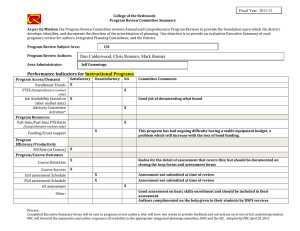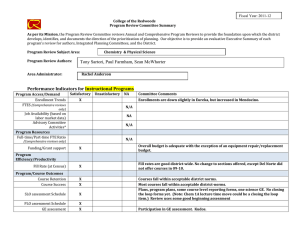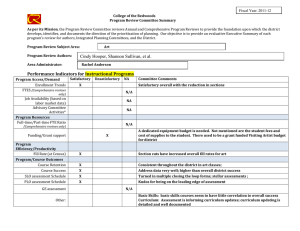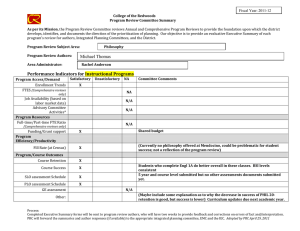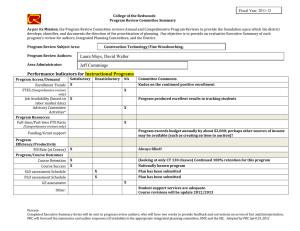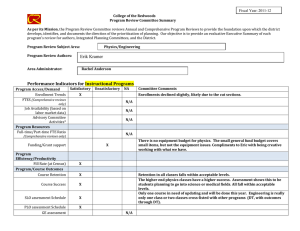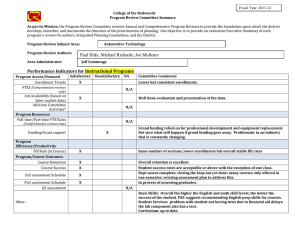DOING A LITERATURE REVIEW
advertisement
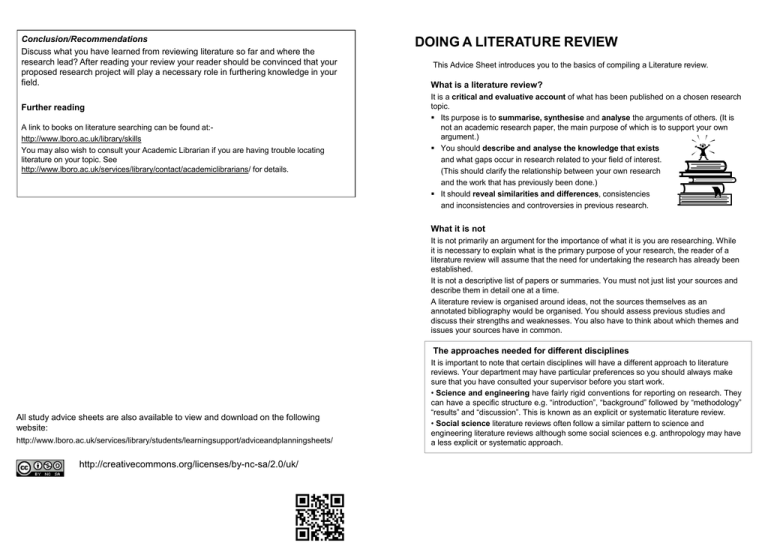
Conclusion/Recommendations Discuss what you have learned from reviewing literature so far and where the research lead? After reading your review your reader should be convinced that your proposed research project will play a necessary role in furthering knowledge in your field. Further reading A link to books on literature searching can be found at:http://www.lboro.ac.uk/library/skills You may also wish to consult your Academic Librarian if you are having trouble locating literature on your topic. See http://www.lboro.ac.uk/services/library/contact/academiclibrarians/ for details. DOING A LITERATURE REVIEW This Advice Sheet introduces you to the basics of compiling a Literature review. What is a literature review? It is a critical and evaluative account of what has been published on a chosen research topic. Its purpose is to summarise, synthesise and analyse the arguments of others. (It is not an academic research paper, the main purpose of which is to support your own argument.) You should describe and analyse the knowledge that exists and what gaps occur in research related to your field of interest. (This should clarify the relationship between your own research and the work that has previously been done.) It should reveal similarities and differences, consistencies and inconsistencies and controversies in previous research. What it is not It is not primarily an argument for the importance of what it is you are researching. While it is necessary to explain what is the primary purpose of your research, the reader of a literature review will assume that the need for undertaking the research has already been established. It is not a descriptive list of papers or summaries. You must not just list your sources and describe them in detail one at a time. A literature review is organised around ideas, not the sources themselves as an annotated bibliography would be organised. You should assess previous studies and discuss their strengths and weaknesses. You also have to think about which themes and issues your sources have in common. The approaches needed for different disciplines All study advice sheets are also available to view and download on the following website: http://www.lboro.ac.uk/services/library/students/learningsupport/adviceandplanningsheets/ http://creativecommons.org/licenses/by-nc-sa/2.0/uk/ It is important to note that certain disciplines will have a different approach to literature reviews. Your department may have particular preferences so you should always make sure that you have consulted your supervisor before you start work. • Science and engineering have fairly rigid conventions for reporting on research. They can have a specific structure e.g. “introduction”, “background” followed by “methodology” “results” and “discussion”. This is known as an explicit or systematic literature review. • Social science literature reviews often follow a similar pattern to science and engineering literature reviews although some social sciences e.g. anthropology may have a less explicit or systematic approach. • Political science literature reviews may have to include a section which establishes basic premises and has definitions of certain terms and models. • Literary and historical literature reviews do not have a single convention. In contemporary literary studies an “explicit” chapter may not be needed. The researcher may be taking a new theoretical approach to material which has already been studied before. Approaching your literature review There are six stages to your literature review: 1. Find models 2. Problem formulation – which topic is under consideration and what are the constituent issues? 3. Literature search 4. Evaluation of findings 5. Analysis and interpretation of literature 6 Writing the literature review 1 Find models Look for other literature reviews in your discipline and read them to get an idea of the types of themes you might want to include in your research or ways in which you could organise your final review. You can do a database search to find models – put the words “literature review” along with your keywords to retrieve references to articles of this type. 2 Problem formulation You should try to construct a working statement that will form the basis of your literature review. The statement does not have to argue for a position or an opinion. It will rather argue for a particular slant on the material. 3 Literature search The literature search will help you identify scope and key issues. Efficient searching will help you: • Identify which authors are interested in your specialism and those who take a generalist’s view. • Trace authors who are prominent in your subject and who can help you justify the importance of your research idea. • Include the authors would or could contradict your ideas. 4 Evaluation of findings Reading research articles is different from other types of reading. You must develop a good understanding of the research literature to be able to write a competent literature review. Understanding the literature requires you to read, re-read and assimilate complex ideas. Read the easier articles first Difficult or badly written articles will probably be easier to understand if you read them last when you have gained familiarity with your subject. Scan the article For the preliminary scan, don’t read the articles closely so as to avoid getting mired in detail. It may help to note down the key points for each article. When reading you should keep the following in mind: What are the authors’ academic reputation? Identify the research question and the specific hypotheses, the findings and how the findings were interpreted. Are the authors objective or does their work appear to have a particular bias? Is contrary data considered and discussed or is it ignored? 5 Analysis and interpretation of the literature After you have an idea of the main ideas in each article, identify the precise methods used and the theories tested. When you are comparing the work of a number of researchers some of whom have a different take on the problems of the research question, you will need to have an in-depth understanding of their work. A close reading may reveal differences in theoretical outlook. How do different authors cite the same work? One author may explain the method of an earlier study, describe its results in great detail and cite it repeatedly while another may give it only a passing reference. Allow enough time Before you can write about your research project you must have evaluated the existing literature properly so do allow yourself sufficient time to do this. 6 Writing the Literature Review Number of articles reviewed Published review articles may contain more than a hundred studies. You may wish to consult your supervisor about how far you should go back in time and how many articles you want to include. Organisation There are a number of different approaches to organising a literature review so again do consult your supervisor before beginning the work. You could use the following method: Introduce your research question (what it is, why it is worth examining) Narrow research question to the studies discussed Briefly outline the organisation of the paper. If there is a major controversy, describe it and explain that you will present research supporting one side and then the other. Or, if three methodologies have been used to address a question, briefly describe them and say that you will compare the results obtained by the three methods Describe studies in detail Compare and evaluate studies Discuss the implications of the studies and how you intend to build on them
